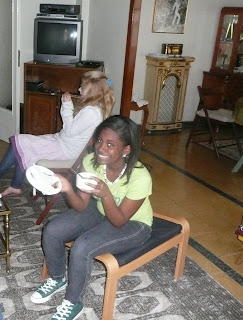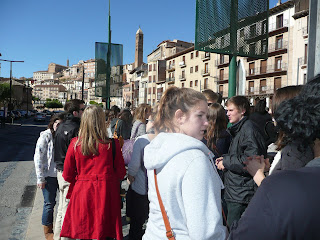For our 3rd
SYA trip, we traveled to the
Veruela Monastery in Vera
de Moncayo, and then to the town of
Tarazona. On the morning of October 25, we once again started our trip by boarding a double
decker bus to start our adventure.
Photo:
SYA students outside the
Veruela Monastery compound (seems like a fortress)

Photo: Colin entering the monastery as students start the tour

Our first stop, the
Veruela Monastery is beautifully situated near the base of the Pyrenees and is less than one hour outside the city of
Zaragoza.
Photos: Inside the monastery


Living in the heart of a city, we find it hard to believe sometimes that we are so close to such amazing natural surroundings. Similar to our other
SYA excursions, we had a guide Spanish guide who took us around to give us an overview of it.
While our Spanish is steadily improving, it's still pretty lightweight; thus, the
SYA trips have been less about grasping all the historical information bequeathed by the guide, and more about getting to know both the faculty and students.
Photo: Parker and Holden (he is in our Spanish class)

However,
fefore the trips, it's been helpful to research the sites on the web in order to have a reasonable background and foundation of knowledge of the site we're seeing.
Veruela is in the oldest part of the Province of
Zaragoza (
Zaragaoza is both a city and a province) and was founded in 1146 by Pedro
de Atarés. With a 20 year construction,
Atarés didn't live to see the completion of
Veruela.
Photo: Colin and Jacob exiting the monastery

A celebrated
Cistercian monastery and church,
Veruela is dedicated to the Blessed Virgin. We learned that the monks only believed in washing their hands and feet and for religious reasons,were forbidden from washing any other part of their bodies...yikes!
Photo: Kelsey inside the monastery. A few of her
SYA gal buddies did her ponytails

Photo: Alex, Mark and Tom (one of Parker's
advisees but alas, a Yankees' fan)

Photo: Regina Saravia (daughter of
SPS family and she attends Exeter

Photo: Chanel (
SPS student) and Taylor (one of Parker's
advisees)

The most famous abbots of
Veruela were Fernando
de Aragón (1498-1577) and Lope Marco (d. 1560). The former was nominated abbot by Charles V in 1537, and two years later became Archbishop of Saragossa. Gustavo
Becquer, the Spanish poet, made
Veruela his abode while the religious were prevented from living there.
Photo: One of the crypts inside the monastery

From 1835 to 1877,
seculars occupied it. Following this period to the present,it has been occupied by the Jesuits, who, assisted by the duchess of
Villahermosa, a descendant of Pedro
de Atarés, restored the church and monastery. Now, the monastery now has a portion which is being converted into a hotel as the Spaniards convert many of their historic sites into lodgings.
Photo: Payton, Ana, Kelsey, Arlene, and Sofie

Photo: Victoria in front of crucifix





















































